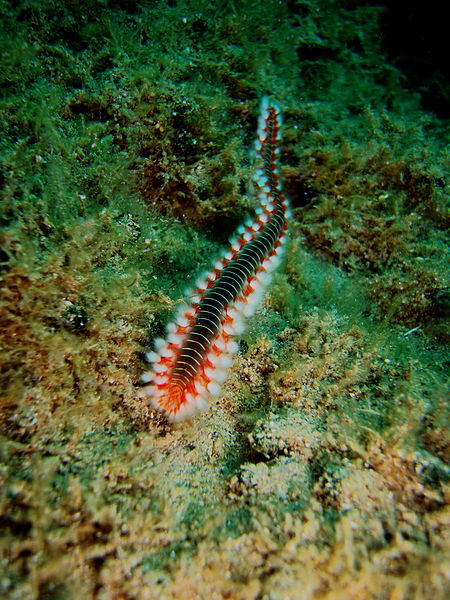Published in the Ocean Watch column, Honolulu Star-Advertiser © Susan Scott
March 25, 2013
“I was badly stung as the worms managed to get into my swimsuit. I ended up with a burning welt across my stomach and fell quite ill,” she wrote. Gerrie still bears the scars, and wonders whether others have had the same experience from what she calls palolo worms.
 A bearded fireworm.
A bearded fireworm.
Used under the Wikimedia Commons liscense. More information:
http://en.wikipedia.org/wiki/Bearded_fireworm
I don’t think Gerrie was stung by the Pacific island delicacy known as the palolo worm, but instead tangled with a species of fireworm. My reasoning: It’s not the bodies of palolo worms that swarm near the surface.It’s their edible sex organs, and those don’t sting.
Palolo worms and fireworms both belong to a class of marine worms called polychetes which contains 5,300 species.Every segment of every polychete body contains a pair of paddlelike appendages, one on each side.
Sedentary polychetes use their paddle feet to hang on to the insides of their tube homes. Other polychetes, such as palolo worms and fireworms, walk on their flat feet at night in search of crustaceans, snails and other worms to eat. During the day, the roamers rest under rocks and in crevices.
Fireworms get their own family among polychetes, because of the bristly bundles that extend, like tiny whisk brooms, from the end of each foot. Fireworms’ other name is bristleworms.
Some fireworms can extend and retract their bristles. When extended, the worm looks like a cute caterpillar — but don’t be tempted to take it home. Those bristles are barbed and filled with poison.
Bright colors advertise some fireworms’ presence, but the pretty hues are warnings. Fish don’t eat fireworms, nor should people touch them. The sharp bristles easily puncture and break off in skin, introducing the toxin that gives fireworms their name.
Palolo worms are not in the fireworm family, nor are the wiggly parts that swarm (and that people eat). These are the worm’s sex organs, developed once a year as long, narrow appendages full of sperm in males and eggs in females. (I wonder whether they taste different.)
The reproductive organs break off from the body eight or nine days after October’s or November’s full moon.Bearing tiny eye spots, the sex appendages reach the surface in pre-dawn darkness, burst open and do their job of making baby worms. The palolo worm’s body remains on the ocean floor.
Many other polychetes, including fireworms, swim to the ocean’s surface to release their sperm and eggs, each species swarming at a precise time of year.
Although Gerrie’s October timing was right for palolo, it’s likely that, by bad luck, she ran into fireworms going about their annual reproductive frenzy.
No specific antidote or diagnostic test exists for fireworm stings. In most victims, after a few days of a rash or sometimes blisters, the injury heals on its own.
Soon I’ll be sailing to, and swimming in, South Pacific waters. I’m hoping that if I have a close encounter of the wormy kind, I’ll be luckier than Gerrie.
Fireworm Mating from Lutfu Tanrıover on Vimeo.